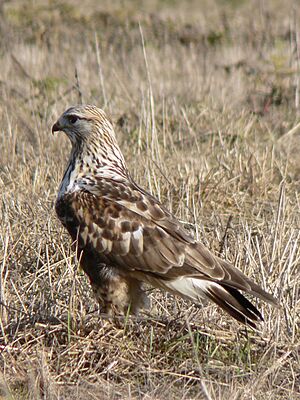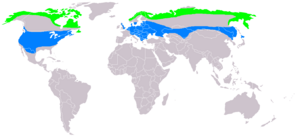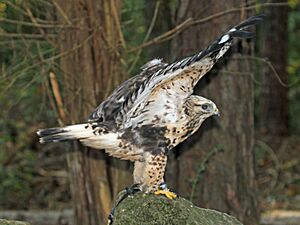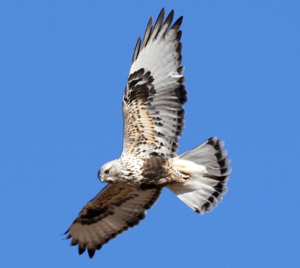Rough-legged buzzard facts for kids
The rough-legged buzzard (in Europe) or rough-legged hawk (in North America) (Buteo lagopus) is a medium-sized bird of prey. These birds live in the cold Arctic and Subarctic areas of North America, Europe, and Russia during summer. When winter comes, they fly south to warmer places. Long ago, people also called them "rough-legged falcons."
Rough-legged buzzards usually build their nests on cliffs or in trees. They lay about three to five eggs, but this number can change depending on how much food is available. These hawks hunt over open land and mostly eat small mammals. They are one of the few birds of prey that can hover in the air, staying in one spot by flapping their wings quickly.
Quick facts for kids Rough-legged buzzard |
|
|---|---|
 |
|
| Conservation status | |
| Scientific classification | |
| Genus: |
Buteo
|
| Species: |
lagopus
|
| Subspecies | |
|
|
 |
|
| Range of B. lagopus Summer Winter | |
Contents
What Does a Rough-legged Buzzard Look Like?
This large bird of prey is about 46 to 68 centimeters (18 to 27 inches) long. Its wings can spread from 120 to 153 centimeters (47 to 60 inches) wide. They usually weigh between 600 and 1660 grams (1.3 to 3.7 pounds). Female birds are typically bigger and heavier than males.
Most of their feathers are brown, often with many speckles. They usually have a wide brown band across their chest. A dark patch on their wrist area, which stands out against their white under-wing, helps identify them. Their feet are covered in feathers all the way to their toes. This helps them stay warm in their cold Arctic homes. The name lagopus comes from Greek words meaning "hare" and "foot," because their feathered feet look a bit like a hare's foot. Their claws are quite small, which matches the small animals they like to hunt.
You can tell them apart from other similar birds by their long white tail feathers. These feathers have one or more dark bands near the end. When the bird is sitting, its wing tips are long enough to reach or go past its tail. The rough-legged buzzard is also the only hawk of its size that regularly hovers in one spot. It does this by beating its wings very fast while looking for food.
Types of Rough-legged Buzzards
The rough-legged buzzard belongs to a group of birds called Buteo. These are medium-sized birds of prey with wide wings, short tails, and strong bodies. In Europe, they are called buzzards, but in North America, they are called hawks.
There are at least three main types of rough-legged buzzards:
- B. l. lagopus: This type lives in northern Europe and Asia. It has darker feathers.
- B. l. sanctijohannis: This type lives in North America. It has lighter, speckled feathers and is a bit smaller.
- B. l. kamtchatkensis: This type lives from northern Siberia to North America near the Pacific Ocean. It has lighter feathers than the North American type and is usually the largest of the three.
Where Do Rough-legged Buzzards Live?
Rough-legged hawks build their nests in cold tundra and taiga areas. These are found in North America and Asia, between 61° and 76° North latitude. The ones in North America fly south to Canada and the central United States for winter. The ones in Europe and Asia fly to southern Europe and Asia. This bird is the only one of its kind found in both northern continents, living all around the North Pole.
During winter, from November to March, they like to live in marshes, prairies, and farm areas. This is where they can find lots of small rodents to eat. They usually choose nesting spots that are open and don't have many trees. They arrive at their nesting grounds in April and May, depending on how much snow there is.
How Do Rough-legged Buzzards Live?
What Do Rough-legged Buzzards Eat?
These birds are meat-eaters. They mostly eat small mammals, which make up most of their diet. Lemmings and voles are their favorite foods. Sometimes, these small animals make up 80-90% of what they eat. Some scientists think these hawks can even see the scent marks left by voles, which helps them find their prey.
Besides rodents, they also eat mice, rats, and other small animals like shrews and squirrels. Birds are their second most common food. They often hunt small songbirds like snow buntings. They might also eat slightly larger birds like ptarmigans, especially young ones. When small mammals are hard to find, rough-legged hawks will hunt bigger animals. These can include prairie dogs, muskrats, or even black-tailed jackrabbits. In winter, they might eat a lot of rabbits.
Rough-legged hawks hunt during the day. They are very good at finding food. They sometimes sit on a perch and wait for prey, then swoop down. They are also known for hovering in the air while looking for food. They need about 80 to 120 grams (2.8 to 4.2 ounces) of food each day. Sometimes, they will even steal food from other birds like red-tailed hawks or common ravens.
Rough-legged Buzzard Reproduction
Rough-legged hawks are ready to have babies when they are about two years old. They usually start breeding in May. These birds are thought to stay with the same partner for many years.
Interestingly, rough-legged buzzards look for good nesting spots in the autumn, not just in spring. After they finish breeding, they fly long distances to find places with lots of rodents. Then, they remember these spots and return to them the next year.
They build their nests quickly after arriving at their breeding grounds, taking about 3 to 4 weeks. They use twigs, grass, and old feathers to build them. Nests are usually 60 to 90 centimeters (24 to 35 inches) wide and 25 to 60 centimeters (10 to 24 inches) tall. They prefer to build nests on cliff ledges or rocky areas.
Females can lay 1 to 7 eggs, but usually lay 3 to 5. The eggs are about 56.4 mm (2.2 inches) long and 44.7 mm (1.8 inches) wide. The mother bird sits on the eggs for at least 31 days. The father bird brings her food during this time. After the eggs hatch, the young birds stay in the nest for 4 to 6 weeks. After they leave the nest, their parents still feed them for another 2 to 4 weeks.
Sometimes, rough-legged hawks nest near peregrine falcons. Peregrines chase away small animals that might eat their eggs. This creates safe spots that rough-legged hawks can use for their own nests.
How Long Do Rough-legged Buzzards Live?
Rough-legged hawks that grow into adults can live for up to 19 years in the wild. One female hawk in a zoo lived to be over 25 years old. However, many young rough-legged hawks do not survive past their first two years.
Young birds face dangers like starving if there isn't enough food. They can also freeze if the weather is very cold when they are in the nest. Humans can also harm them. Other animals can eat the young birds. Arctic foxes, brown bears, and wolverines can eat eggs and young if they can reach the nests. Bird scavengers, like groups of common ravens and skuas, also eat eggs and nestlings. Snowy owls might also hunt them.
Adult rough-legged hawks are large birds of prey, so they have fewer natural enemies. But they can die in fights, especially when protecting their nests. Other large birds of prey, like golden eagles and large falcons, sometimes hunt them. In winter, they might be hunted at night by large owls.
Besides predators, young birds can die for other reasons. Baby birds in their first two weeks cannot control their body temperature well. In the open tundra, they might leave the nest to find shade from the sun. If a sudden thunderstorm hits (which is common in the Arctic), the young birds can die quickly if their parents are not there to protect them. Landslides near riverbanks, where they often nest, can also cause deaths.
What Sounds Do Rough-legged Buzzards Make?
Adult rough-legged hawks make alarm calls when someone gets too close to their nest. It sounds like a whistle that goes down in pitch, like "kiu wiyuk" or a long, falling "kee-eer." They make this sound every 15 to 30 seconds while flying or sitting.
During courtship, both male and female birds make a whistling sound that changes to a hiss. After mating, females make a clucking sound, and males make a whistling noise. Young birds make begging calls when they want their parents to bring them food.






